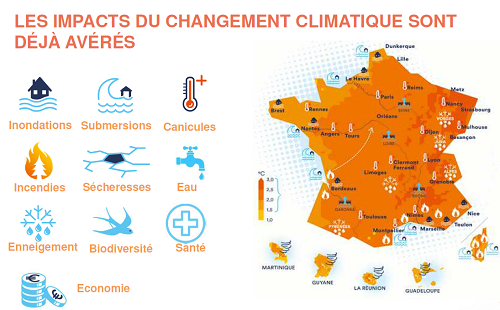
Organized for HUSZPO, the Croatian association of experts in nature and environmental protection, with the support of the French Embassy in Croatia, the Croatian Ministry of Economy and Sustainable Development and the City of Zagreb, this half-day webinar, organized and moderated by the Research, Innovation and International Department of Cerema, provided an opportunity to share French methods and practices to integrate climate change and its impacts into strategic environmental assessment.
After an introduction of the day by the president of the president of the HUSZPO, the counsellor for the cooperation and cultural action of the French embassy in Croatia as well as the director of the French Institute in Croatia and the director of the General Directorate for Climate Action of the Croatian Ministry of Economy and Sustainable Development, Géraldine Bur (Cerema) spoke about on the integration of climate change into local players’ agendas and Gilles Chapelier (Cerema) on the subject of expertise on environmental assessment in France.
High stakes in France in view of the evolution scenarios of climate change
Cerema quickly presented its position as a positioning, as a public establishment intervening with intervening with the services of the State as well as and socio-economic stakeholders. One its priority areas of work is the adapting local players to climate change, positioning itself transversally to the to the six areas of activity.
After a brief reminder on climate change and particularly on the more particularly on the state of play of the issues, the data available data in France, the stakeholders involved, Cerema presented examples of of maps of hazards amplified with the increase of temperatures: floods, heat waves, marine submersions, droughts, water quality, snow cover, with impacts on biodiversity, health and the economy.

At the level of strategic planning of territories, one of the challenges is to determine the future climate change trends at a local scale, according to different scenarios of temperature increase. The scenarios for France include :
-
An increase in heat waves
-
Drier soil in all seasons seasons: it is expected that by the end of the 21 st century, soil moisture will be similar to the one we know today. extreme drought situations.
-
Important economic impacts, up to a 10-fold increase in costs related to infrastructure damage.
Cerema then presented the public policies policies implemented in France to face up to climate change and to adapt local players, deployed through the National Low Carbon Strategy, which aims to reduce greenhouse gas emissions and mitigate climate change, and the National Climate Change Adaptation Plan (PNACC) with the objective of achieving carbon neutrality by 2050.
For example, the PNACC aims to strengthen the involvement of local stakeholders and economic sectors or to give priority to nature-based solutions.
Planning documents are one of the main levers available to territories to integrate the challenges of climate change in areas such as urban planning, forestry, energy waste, housing or the coastline and to encourage the practices in order to improve the resilience of territories.
To define an action program, it is first necessary to carry out precise diagnoses on the scale of the concerned areas. The stakeholders can rely on a series of indicators defined and monitored by the National Observatory of the Effects of Climate Change, which allow them to visualize the data at the local level. From software tools such as Clim Urba or GHG Urba, or the resource center on adaptation to climate change.
Integrating climate change into the environmental assessment of project

The strategic environmental assessment of plans and programs is to reduce the impact of plans and programs on environment, heritage and health. A European directive frames this exercise which applies to :
-
environmental plans (water management, waste management, health, ... )
-
plans related to activities (quarries, forests, energy, ...)
-
territorial strategies (PLUi, SCOT, SRADDET, ..)
Cerema presented the environmental assessment process, which must be based on scientific sources and integrate climate change in all stages, from the presentation of the plan or project to environmental impact avoidance, reduction or compensation measures.
Examples from the "state of the environment” and impact analysis sections of the environmental the environmental assessment for the multi-year energy program of the environmental assessment for the multiannual energy program (PPE) deployed the national level, for the Celtic Seas Marine Action Plan (MSFD) of the Regional Wood Plan of the Grand Est region, regional planning, sustainable territorial development and equality of territories (SRADDET) or even the Territorial Climate Air and Energy Plan (PCAET) have been developed.
Cerema then presented examples of measures taken to avoid, reduce or, failing that, compensate (ERC) the impacts of planning on climate change and, more broadly, of the mitigation and adaptation measures present in different planning processes in France.
Through its SRADDET, Occitania has set objectives such as reconciling development and preservation resources (zero net artificialization and no net loss of biodiversity in 2040, sharing water between different uses), reducing energy consumption (by increasing production, acting on decarbonized transport, recovering waste...), ensuring adaptation to climate change, particularly on the coast. The goal is to implement actions specifically targeted at the identified issues.
In conclusion, Cerema presented the main developments in environmental assessment since its implementation in France, with a better quality of local data, greater integration climate change in planning and better awareness of all stakeholders, but there are still many areas for improvement!

